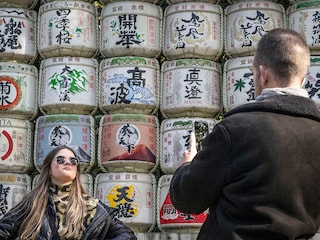All you need to know about Japanese sake
Here's how sake, a rice wine, is made, its myriad varieties, and its role in everyday life and traditions


Japanese tipples sake and shochu—and the knowledge and skills honed over centuries to make them —have been added to UNESCO"s Intangible Cultural Heritage list.
AFP looks at how sake, a rice wine, is made, its myriad varieties, and its role in everyday life and traditions:
By around 1000 AD, the imperial palace had a department to supervise the manufacturing of sake and its use in rituals, according to the Japan Sake and Shochu Makers Association.
The multi-staged brewing techniques still used today are thought to have been established around the 1700s.
Nowadays there are around 1,400 sake breweries in Japan.
Shochu, which was also added to UNESCO"s Intangible Cultural Heritage list on Wednesday, is a spirit distilled from different ingredients such as sweet potato, mainly in the country"s southwest.
First, the grains are polished to remove the outer layers, revealing a water-absorbent white core rich in starch.
Brewers wash, soak and steam the polished rice before growing a special mould on it called koji. They then mix it with water and yeast to create a starter.
Adding more steamed rice and water several times sparks two types of chemical reactions in a single cask—converting starch to sugar and sugar to alcohol—a more complex process than making wine from sugar-rich grapes.
The genus designated as Japan"s national mould is called aspergillus oryzae, also known as "koji-kabi".
"Over more than a thousand years, brewers selected and cultivated the best type of mould from all the wild ones out there," Taku Takahashi, from Tokyo"s Toshimaya Shuzo brewery, told AFP.
The sake-making process as we know it now, where humans intervene to spark fermentation, was developed "after many, many failures", he added.
The higher the grade of grain polishing, the fruitier and drier the sake.
More polished varieties requiring more rice tend to be pricier, but some gastronomists appreciate less polished types for their rich and mellow flavour.
Breweries adjust their flavours to suit local delicacies. For example, near the Pacific Ocean, dry sake is produced to pair with red-meat fish such as tuna and bonito.
It is also drunk to mark store openings and election victories -- or just to say "kampai" meaning "cheers" in Japanese pubs.
Traditionally three ritual offerings are made to the many gods of Japan"s Shinto religion: rice, a rice cake and sake.
And at Shinto weddings, the bride and groom drink sake from the same porcelain cup to symbolise their union.
Breweries still hang a ball of cedar leaves outside, which change colour from green to brown -- letting customers know when the "nouveau" sake is ready in early winter.
The agriculture ministry says the country drank only 390 million litres of sake in 2023, down from 1.7 billion litres in 1973.
However, exports of sake have more than doubled since 2011, and it is now brewed as far afield as New Zealand, France and the United States.
First Published: Dec 07, 2024, 10:09
Subscribe Now